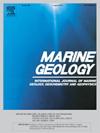Decadal shifts and future projections of the Han River Delta coastline
IF 2.2
3区 地球科学
Q2 GEOSCIENCES, MULTIDISCIPLINARY
引用次数: 0
Abstract
The Han River Delta, the sixth largest delta in China, has received decreasing amounts of fluvial sediments over the last decades. Here, we use satellite images for 1981–2020 and a conceptual geometric model to investigate recent and future evolution of the delta coastline. Satellite images were able to capture the transition from a more natural coastline with sandy beaches to an artificial structure since 2015. This transition has been accompanied by rapid seaward migration of a portion of the artificial coastline due to land reclamation. Furthermore, most of the coastline has remained stable (showing no significant advance or retreat), except for coastlines that are dominated by mangrove forest. The coastline has not always remained stable. Before the 1980s, the coastline was continuously advancing. Modeling results reveal that a significant reduction of fluvial sediment, mainly caused by upstream dam emplacement, had a key role in the shifting status of the delta coastline evolution. Additionally, model results suggest that if fluvial sediment supply had remained consistent with pre-dam levels, the more abundant fluvial sediment supply could counteract the effects of a maximum sea-level rise scenario for decades. However, a sustained decrease of the fluvial sediment supply, at rates similar to the less abundant sediment supply at present, is expected to dominate the evolution of the delta coastline under a conservative sea level rise scenario. In the case of a medium or maximum sea level rise scenario, the future evolution of the delta coastline will be dominated by the rate at which sea level rises, rather than a further decrease of riverine sediment. The large-scale land reclamation has a negligible impact on the advance or retreat rate of the delta coastline. These findings offer valuable insights for the management of delta coastlines.
汉江三角洲海岸线的年代际变化和未来预测
汉江三角洲是中国第六大三角洲,在过去的几十年里,河流沉积物的数量不断减少。本文利用1981-2020年的卫星图像和一个概念几何模型来研究三角洲海岸线最近和未来的演变。自2015年以来,卫星图像能够捕捉到从更自然的海岸线和沙滩到人工结构的转变。这种转变伴随着部分人工海岸线因填海造地而迅速向海迁移。此外,除了以红树林为主的海岸线外,大部分海岸线保持稳定(没有明显的前进或后退)。海岸线并不总是保持稳定。20世纪80年代以前,海岸线在不断推进。模拟结果表明,河流沉积物的显著减少(主要是上游坝位造成的)对三角洲海岸线演化的转移状态起着关键作用。此外,模型结果表明,如果河流沉积物供应与大坝建成前的水平保持一致,那么更丰富的河流沉积物供应可以抵消几十年来海平面最大上升情景的影响。然而,在保守的海平面上升情景下,河流沉积物供应的持续减少,其速度与目前较少的沉积物供应相似,预计将主导三角洲海岸线的演变。在中等或最大海平面上升的情况下,三角洲海岸线的未来演变将由海平面上升的速度决定,而不是河流沉积物的进一步减少。大规模的填海造地对三角洲海岸线推进或后退速度的影响可以忽略不计。这些发现为三角洲海岸线的管理提供了有价值的见解。
本文章由计算机程序翻译,如有差异,请以英文原文为准。
求助全文
约1分钟内获得全文
求助全文
来源期刊

Marine Geology
地学-地球科学综合
CiteScore
6.10
自引率
6.90%
发文量
175
审稿时长
21.9 weeks
期刊介绍:
Marine Geology is the premier international journal on marine geological processes in the broadest sense. We seek papers that are comprehensive, interdisciplinary and synthetic that will be lasting contributions to the field. Although most papers are based on regional studies, they must demonstrate new findings of international significance. We accept papers on subjects as diverse as seafloor hydrothermal systems, beach dynamics, early diagenesis, microbiological studies in sediments, palaeoclimate studies and geophysical studies of the seabed. We encourage papers that address emerging new fields, for example the influence of anthropogenic processes on coastal/marine geology and coastal/marine geoarchaeology. We insist that the papers are concerned with the marine realm and that they deal with geology: with rocks, sediments, and physical and chemical processes affecting them. Papers should address scientific hypotheses: highly descriptive data compilations or papers that deal only with marine management and risk assessment should be submitted to other journals. Papers on laboratory or modelling studies must demonstrate direct relevance to marine processes or deposits. The primary criteria for acceptance of papers is that the science is of high quality, novel, significant, and of broad international interest.
 求助内容:
求助内容: 应助结果提醒方式:
应助结果提醒方式:


